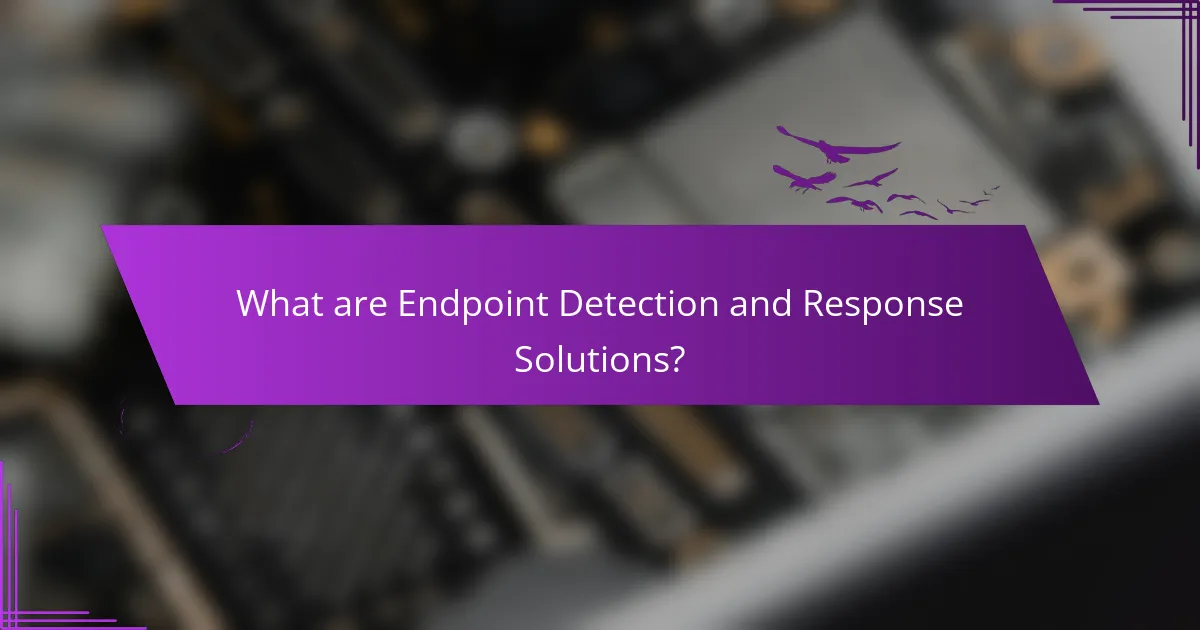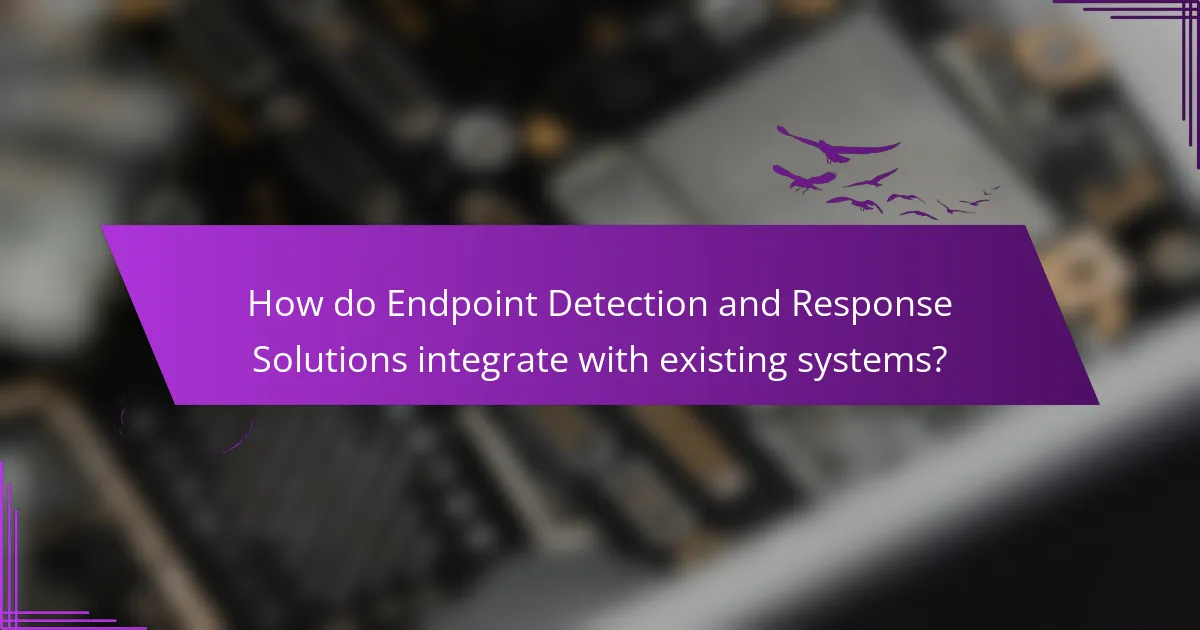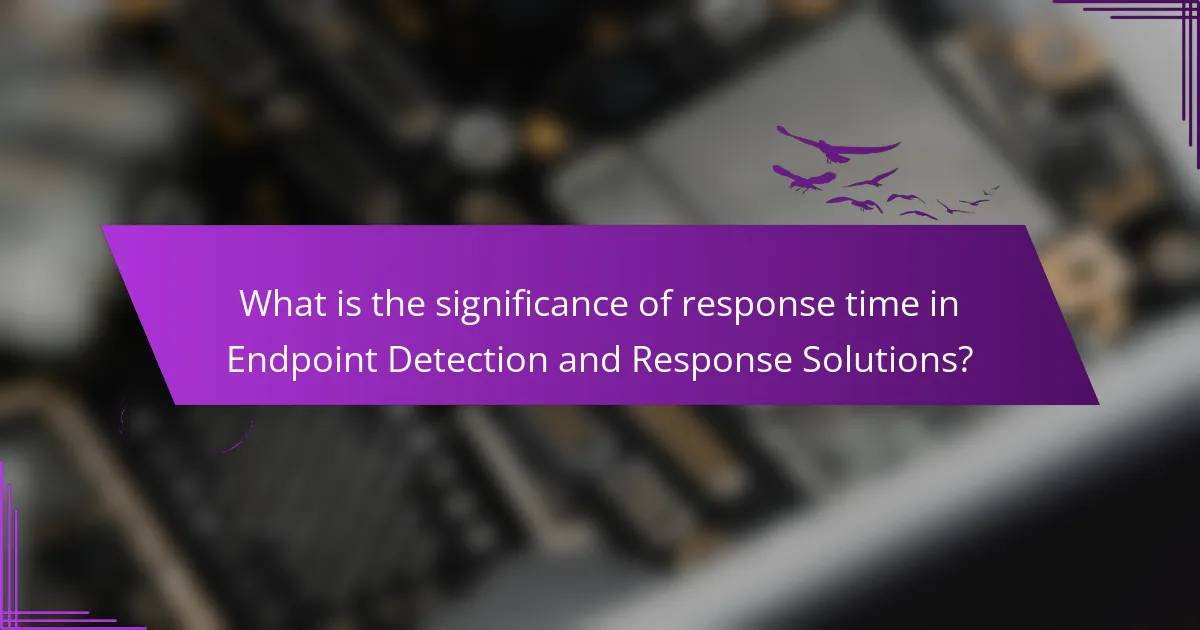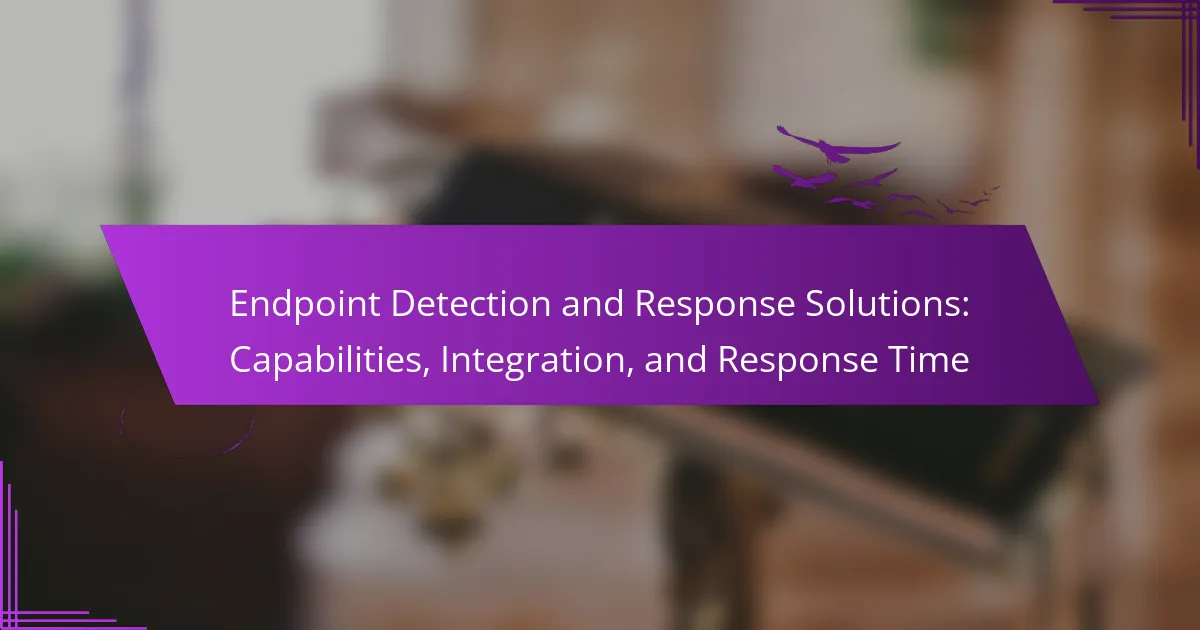
What are Endpoint Detection and Response Solutions?
Endpoint Detection and Response (EDR) solutions are security tools designed to monitor, detect, and respond to threats on endpoints. They provide real-time visibility into endpoint activities and can identify suspicious behavior. EDR solutions leverage advanced analytics and machine learning to detect anomalies. They also facilitate automated responses to mitigate threats. The market for EDR solutions has grown significantly, with a projected CAGR of 22% from 2021 to 2028, indicating increasing demand for endpoint security. These solutions are critical in modern cybersecurity strategies to protect against sophisticated attacks.
How do Endpoint Detection and Response Solutions function?
Endpoint Detection and Response (EDR) solutions function by continuously monitoring endpoint activities for suspicious behavior. They collect data from endpoints, such as servers and workstations. This data includes file changes, process executions, and network connections. EDR systems analyze this data in real-time using behavioral analysis and threat intelligence. When a potential threat is detected, EDR solutions generate alerts for security teams. They also provide tools for incident response, allowing teams to investigate and remediate threats. According to a report by Gartner, EDR solutions significantly reduce the time to detect and respond to security incidents.
What are the key components of Endpoint Detection and Response Solutions?
The key components of Endpoint Detection and Response (EDR) solutions include data collection, threat detection, incident response, and reporting. Data collection involves gathering telemetry from endpoints to monitor activities. Threat detection uses algorithms and behavioral analysis to identify anomalies and potential threats. Incident response provides tools for containment, eradication, and recovery from threats. Reporting offers insights into security incidents and system performance. These components work together to enhance endpoint security and provide comprehensive protection against cyber threats.
How do these components interact to enhance security?
Endpoint Detection and Response (EDR) solutions enhance security through the integration of various components. These components include threat detection, data collection, and response mechanisms. Threat detection identifies potential security incidents in real-time. Data collection aggregates information from endpoints to provide a comprehensive view of security events. Response mechanisms enable automated actions to mitigate threats swiftly.
The interaction between these components creates a proactive security posture. For example, when a threat is detected, the data collected helps in understanding the attack’s context. This context allows security teams to respond effectively. Additionally, continuous monitoring ensures that new threats are identified promptly.
Research indicates that organizations utilizing EDR solutions experience a 50% reduction in breach costs (Ponemon Institute, 2020). This statistic supports the efficacy of EDR components working together to enhance overall security.
What capabilities do Endpoint Detection and Response Solutions provide?
Endpoint Detection and Response (EDR) solutions provide capabilities for detecting, investigating, and responding to threats on endpoints. They monitor endpoint activities in real-time to identify suspicious behavior. EDR solutions analyze data from various sources, including files and processes, to detect anomalies. They offer automated response actions to contain and remediate threats quickly. EDR solutions also provide threat intelligence and analytics to enhance security posture. Additionally, they enable forensic analysis to understand the nature of attacks. These capabilities are essential for minimizing the impact of security incidents on organizations.
Which detection techniques are utilized in Endpoint Detection and Response Solutions?
Endpoint Detection and Response (EDR) solutions utilize several detection techniques. These include behavioral analysis, which monitors user and entity behavior for anomalies. Signature-based detection identifies known threats using predefined signatures. Heuristic analysis evaluates the behavior of files and applications to detect potential threats. Machine learning algorithms analyze vast amounts of data to identify patterns indicative of malicious activity. Network traffic analysis inspects data packets for signs of intrusion or abnormal behavior. Finally, threat intelligence integration provides contextual information about emerging threats. These techniques collectively enhance the ability of EDR solutions to detect and respond to security incidents effectively.
How do these solutions respond to threats?
Endpoint Detection and Response (EDR) solutions respond to threats through continuous monitoring and automated response capabilities. They analyze endpoint activity to identify suspicious behaviors in real-time. EDR solutions utilize threat intelligence to correlate data and detect anomalies. They can isolate affected endpoints to prevent lateral movement of threats. Additionally, they provide forensic analysis to understand the attack vector. EDR solutions often automate remediation processes to swiftly eliminate threats. This rapid response minimizes potential damage and downtime. Studies show that organizations using EDR can reduce incident response times significantly, enhancing overall security posture.

How do Endpoint Detection and Response Solutions integrate with existing systems?
Endpoint Detection and Response (EDR) solutions integrate with existing systems through API connections and centralized management consoles. These integrations enable seamless data sharing between EDR tools and other security solutions, such as Security Information and Event Management (SIEM) systems. EDR solutions can also enhance endpoint visibility by collecting telemetry from various devices across the network. This data is analyzed in real-time to identify threats and respond effectively.
Furthermore, EDR solutions often support integration with threat intelligence feeds. This allows organizations to receive up-to-date information on emerging threats. By leveraging existing infrastructure, EDR solutions can also automate response actions, such as isolating infected devices. This automation improves incident response times and reduces manual intervention.
According to a report by Gartner, effective integration of EDR with existing systems can lead to a 30% reduction in the time taken to detect and respond to security incidents. This highlights the importance of EDR solutions in enhancing overall security posture.
What are the common integration methods for Endpoint Detection and Response Solutions?
Common integration methods for Endpoint Detection and Response (EDR) solutions include API integrations, Security Information and Event Management (SIEM) integrations, and threat intelligence feeds. API integrations allow EDR solutions to communicate with other security tools and platforms seamlessly. SIEM integrations enable centralized logging and analysis of security events for better visibility. Threat intelligence feeds provide real-time data on emerging threats, enhancing the EDR’s response capabilities. These methods enhance the overall security posture by enabling better data sharing and coordinated responses across systems.
How do these integration methods affect overall security posture?
Integration methods enhance overall security posture by improving threat detection and response capabilities. They enable seamless communication between security tools, allowing for quicker identification of vulnerabilities. For instance, integrating Endpoint Detection and Response (EDR) with Security Information and Event Management (SIEM) systems consolidates data for better analysis. This integration can reduce response time to incidents by up to 50%, according to industry reports. Additionally, automated workflows from these integrations minimize human error, increasing the accuracy of threat responses. Ultimately, effective integration methods create a more resilient security framework capable of adapting to evolving threats.
What challenges may arise during integration?
Integration of Endpoint Detection and Response (EDR) solutions can present several challenges. These challenges include compatibility issues with existing systems. Different software and hardware configurations may not work seamlessly together. Data silos can also hinder effective integration. When data is isolated, it complicates the analysis and response processes. Another challenge is the complexity of configuration. Properly setting up EDR solutions requires significant technical expertise. Additionally, user resistance may occur during the integration process. Employees may be reluctant to adopt new technologies. Finally, ongoing maintenance and updates can pose logistical challenges. Regular updates are essential for optimal performance but can disrupt existing workflows.
How can organizations ensure effective integration of Endpoint Detection and Response Solutions?
Organizations can ensure effective integration of Endpoint Detection and Response (EDR) solutions by following a structured approach. First, they should assess their existing security infrastructure. This includes identifying gaps that EDR can fill. Next, they must define clear objectives for EDR deployment. This helps in aligning the solution with organizational goals.
Training staff on EDR tools is crucial. Well-trained personnel can maximize the tool’s capabilities. Organizations should also establish robust policies for incident response. These policies guide how to act when threats are detected.
Regularly updating the EDR system is necessary to keep up with evolving threats. Continuous monitoring and analysis of alerts enhance threat detection. Finally, integrating EDR with other security solutions creates a comprehensive defense strategy. This multi-layered approach significantly improves overall security posture.
What best practices should be followed for smooth integration?
To achieve smooth integration of Endpoint Detection and Response (EDR) solutions, follow best practices such as thorough planning and clear communication. Establish a detailed integration strategy that outlines objectives and timelines. Engage all stakeholders early in the process to address concerns and gather input. Ensure compatibility between EDR solutions and existing systems to avoid disruptions. Conduct comprehensive training for staff to familiarize them with new tools and processes. Regularly monitor integration progress and adjust the plan as necessary. According to a study by Gartner, organizations that prioritize these practices experience 30% fewer integration-related issues.
How can training improve integration success?
Training enhances integration success by equipping teams with the necessary skills and knowledge. It ensures that employees understand the capabilities of Endpoint Detection and Response (EDR) solutions. This understanding leads to more effective utilization of the tools during integration. Training also fosters collaboration among team members, improving communication and reducing misunderstandings.
Research shows that organizations with comprehensive training programs have a 20% higher success rate in technology integration. Additionally, well-trained staff can identify and resolve issues faster, minimizing downtime during the integration process. Overall, targeted training directly contributes to smoother and more efficient integration of EDR solutions.

What is the significance of response time in Endpoint Detection and Response Solutions?
Response time in Endpoint Detection and Response (EDR) solutions is critical for minimizing damage during a security incident. Quick response times enable organizations to contain threats before they escalate. EDR solutions typically aim for response times in seconds to minutes. This rapid action can significantly reduce the window of opportunity for attackers. According to a study by IBM, organizations with faster incident response times can save millions in potential losses. Additionally, timely responses help maintain compliance with regulatory requirements. Overall, effective response time enhances the overall security posture of an organization.
How does response time impact the effectiveness of Endpoint Detection and Response Solutions?
Response time significantly impacts the effectiveness of Endpoint Detection and Response (EDR) solutions. A faster response time allows for quicker identification and remediation of threats. This minimizes potential damage and reduces the window of opportunity for attackers. According to a report by IBM, organizations that can respond to threats within 24 hours experience 50% less financial impact than those that take longer. Effective EDR solutions often operate in real-time, enabling immediate actions against detected anomalies. Thus, optimal response times are crucial for maintaining security and mitigating risks effectively.
What factors influence response time?
Response time is influenced by several factors including system performance, network latency, and the complexity of the incident. System performance refers to the hardware and software capabilities of the endpoint detection and response (EDR) solution. High-performance systems can process data and respond more quickly. Network latency affects how fast data can be transmitted between endpoints and the central management console. Lower latency leads to faster response times.
The complexity of the incident also plays a significant role. More complex incidents may require additional analysis and decision-making, which can delay response. Furthermore, the effectiveness of the incident response team can impact the speed of response. Well-trained teams can act more efficiently. Lastly, integration with other security tools can either streamline or complicate the response process, affecting overall response time.
How can organizations measure and improve response time?
Organizations can measure response time by utilizing key performance indicators (KPIs) such as average response time and time to resolution. These metrics provide a quantifiable way to assess how quickly incidents are addressed. Tools like incident management software can track these metrics in real-time.
To improve response time, organizations should implement automated alert systems. Automation reduces manual intervention, allowing for quicker responses. Additionally, regular training for response teams enhances their efficiency. A well-trained team can respond faster to incidents.
Investing in advanced endpoint detection and response solutions also aids in improving response time. These solutions provide real-time monitoring and analytics. According to a study by Ponemon Institute, organizations using automated solutions can reduce response times by up to 50%.
By regularly reviewing and analyzing response data, organizations can identify bottlenecks and areas for improvement. Continuous assessment ensures that response strategies remain effective and efficient.
What are the implications of delayed response times?
Delayed response times in endpoint detection and response solutions can lead to significant security vulnerabilities. These delays can result in prolonged exposure to threats, increasing the likelihood of data breaches. According to a report by IBM, organizations with faster incident response times can reduce the cost of a data breach by an average of $1.2 million. Furthermore, delayed responses can hinder the ability to contain and neutralize attacks effectively, allowing malware to spread across networks. This can compromise sensitive information and disrupt business operations. Inadequate response times can also damage an organization’s reputation, leading to loss of customer trust and potential financial losses.
How can organizations mitigate risks associated with slow response times?
Organizations can mitigate risks associated with slow response times by implementing automated incident response systems. These systems can significantly reduce the time taken to detect and respond to threats. Automation can streamline workflows and minimize human error. Regularly updating and maintaining endpoint detection solutions is also crucial. This ensures that the systems operate efficiently and effectively. Training staff on best practices for rapid response enhances overall preparedness. According to a report by IBM, organizations with automated response capabilities can reduce incident response times by up to 50%. This statistic underscores the effectiveness of automation in addressing slow response times.
What technologies can enhance response time in Endpoint Detection and Response Solutions?
Artificial intelligence (AI) and machine learning (ML) technologies can enhance response time in Endpoint Detection and Response (EDR) solutions. These technologies enable faster threat detection by analyzing vast amounts of data in real time. AI algorithms can identify patterns and anomalies that indicate potential threats. Machine learning models improve over time by learning from past incidents, increasing their accuracy. Automation technologies also play a crucial role. They facilitate immediate responses to detected threats, reducing the time between detection and action. Integration with threat intelligence platforms further enhances response capabilities. This allows EDR solutions to leverage external data for quicker decision-making. Collectively, these technologies significantly improve the efficiency and speed of response in EDR systems.
What are the best practices for optimizing Endpoint Detection and Response Solutions?
Regularly update the Endpoint Detection and Response (EDR) solutions to ensure they have the latest threat intelligence. This practice enhances detection capabilities against new and evolving threats. Implementing automated response mechanisms can significantly reduce response times during incidents. Automating responses allows for swift containment and remediation actions.
Conduct regular training sessions for security teams to improve their proficiency with EDR tools. Well-trained personnel can more effectively analyze alerts and respond to incidents. Establish clear incident response protocols to guide actions during a security event. Defined procedures help streamline the response process and minimize confusion.
Utilize centralized logging to collect and analyze data from all endpoints. Centralized logs provide a comprehensive view of activities, making it easier to identify anomalies. Regularly review and tune detection rules to reduce false positives. Fine-tuning ensures that alerts are relevant and actionable, improving overall efficiency.
Integrate EDR solutions with other security tools for comprehensive protection. This integration creates a unified security posture and enhances incident response capabilities. Monitor the performance of the EDR solution continuously to identify areas for improvement. Ongoing performance assessment helps maintain optimal functionality and effectiveness.
How can regular updates enhance the effectiveness of these solutions?
Regular updates enhance the effectiveness of Endpoint Detection and Response (EDR) solutions by improving their ability to detect and respond to new threats. These updates often include the latest threat intelligence, which helps systems recognize emerging malware and attack techniques. Additionally, updates can fix vulnerabilities in the software, preventing exploitation by attackers. A study by the Ponemon Institute found that organizations with regularly updated security solutions experience 30% fewer breaches. Furthermore, updates can optimize performance, ensuring faster response times during incidents. Regularly updated EDR solutions maintain compliance with industry standards, which is crucial for organizational security posture.
What role does user training play in maximizing the benefits of Endpoint Detection and Response Solutions?
User training is crucial for maximizing the benefits of Endpoint Detection and Response (EDR) solutions. Effective training ensures that users understand how to utilize EDR tools properly. It enhances their ability to recognize potential threats and respond appropriately. Trained users are more likely to follow security protocols, reducing the risk of breaches. Research indicates that organizations with comprehensive training programs experience fewer security incidents. For example, a study by the Ponemon Institute found that organizations with robust training saw a 45% reduction in security breaches. This highlights the direct correlation between user training and the effectiveness of EDR solutions.
Endpoint Detection and Response (EDR) solutions are critical cybersecurity tools that monitor, detect, and respond to threats on endpoints, providing real-time visibility and utilizing advanced analytics. This article explores the functionalities of EDR solutions, including their key components like data collection and incident response, and their integration with existing systems to enhance overall security posture. It also examines the significance of response time in mitigating security incidents and discusses best practices for optimizing EDR effectiveness through regular updates and user training. Additionally, the article highlights the challenges organizations may face during integration and offers strategies to ensure successful deployment and operation of EDR solutions.
